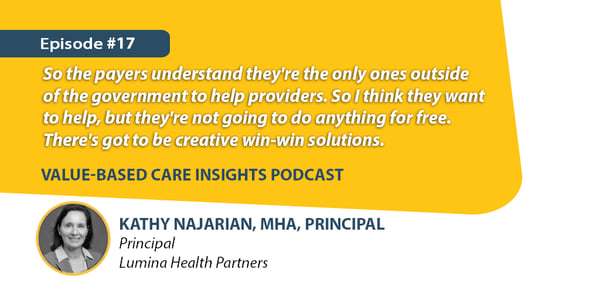Episode Overview:
COVID-19 has left healthcare leaders scrambling to adjust to a new normal. As organizations navigate the post-pandemic landscape, leaders are looking for ways to drive margin enhancement while safely ramping up service delivery.
In this two-part series, Daniel J. Marino and Shaillee Chopra first talk with colleague Kathy Najarian to learn her top strategies for working with payers to claim the revenue lost from decreased volume during the pandemic. Next, Rick Howard shares his insights on reducing cost by managing variable costs and doing more with what leaders already have.
Co-hosts:

Daniel J. Marino, Managing Partner, Lumina Health Partners

Shaillee Chopra, Principal, Lumina Health Partners
Guests:
 Kathy Najarian, MHA, Principal, Lumina Health Partners
Kathy Najarian, MHA, Principal, Lumina Health Partners
 Rick Howard, Principal, Lumina Health Partners
Rick Howard, Principal, Lumina Health Partners
Episode Discussion Areas:
1. What are providers saying about the financial impact of COVID?
- All elective surgeries and ambulatory visits were canceled.
- The decrease in utilization is devastating to hospitals and physicians.
- Health systems cannot survive on inpatient medical cases, and certainly not on severe cases, such as COVID-19 and ICU cases.
2. How can CFOs and VPs negotiate with health plan carriers to infuse cash flow?
- Payers see the devastation and understand that a hospital’s independent physician group could go out of business.
- Payers understand they’re the only ones outside of the government to help providers.
- They want to help, but because they’re not going to do anything for free, there must be creative win-win solutions.
3. What can providers do to help accelerate performance-based reimbursement?
- Take a pulse check to see how you’re doing so far during the performance period.
- Payers and providers should reexamine their value-based care arrangements and see how they might need to be renegotiated. This can be an exciting opportunity for organizations that haven’t yet started with value-based care contracting.
- Now is a good time to start having these conversations with payers because it can create the right future environment, increase budgeted cash flows coming in, and receive prospective care management fees.
4. What are some critical areas to focus on to drive these results?
- On the acute care side, questions might include:
- What is the cost of a specific DRG-based procedure?
- Is there variability in that procedure from physician to physician?
- Assess how patients are being scheduled and registered.
- Consider different cost models and different staffing models as part of the new norm.
5. What outcomes should organizations begin to focus on?
- Review an increase in quality, since it may be tied to value-based contracts.
- Create a physician engagement approach that will give physicians a “loyalty factor” to the health system.
6. How much money has been spent on improving clinical variation?
- Look at the percentage of GDP that healthcare represents today.
- Calculate your service line level cost and try to gain insight.
- Manage that cost to create the efficiencies and changes necessary to retain revenue and a healthy margin.

12 Key Takeaways: Revenue Recovery, Cost Management, and Clinical Variation Tips
- How can hospitals look at costs through a new lens?
- While cash flow might be good thanks to government subsidies and other loans, loans may need to be paid back — and that paints a different picture on the balance sheet.
- Due to a reduction in elective surgeries during the pandemic, hospitals need to start finding ways to reduce expenses, improve margins and recover revenue.
- Many hospitals are at a 1%-3% operating margin while experiencing up to a 50% reduction in revenue.
- Now is the time to negotiate with carriers for a cash infusion.
- With hospital margins plummeting and financial ratings moving to negative, payers are starting to understand they’re the only ones (outside of the government) in a position to help providers. But they won’t do it for free. Developing some creative win-win solutions will be essential to refocus the economic structure.
- What can CFOs and VPs of managed care do to negotiate with payers?
- They can leverage existing relationships, calculate financial model projections, and be transparent with the payers.
- Providers should focus on the ask — negotiate with payers on options for cash infusion, add quality incentives to contracts, receive money on incentives earlier, and move care to different sites — can help ensure the economic viability of an organization.
- Can providers accelerate payments in some value-based care contracts?
- If you have a solid track record, you might be able to negotiate an upfront payment based on how you’re doing and how you did in the last five years. You might even be able to review your value-based care arrangements and renegotiate risk terms. And if you haven’t already started with value-based contracts, now might be the perfect time to do so.
- How can providers negotiate the right rates for telehealth services?
- Telehealth services offer the potential for so many new connection points between care coordinators and patients. But in the past, commercial payers have tried to establish one solution for telehealth reimbursement and contracts. Now is a great time to go to payers and ask to establish a permanent addition to contracts to add telehealth and negotiate for that same level of reimbursement (as in person visits).
- One untapped area is the Centers of Excellence direct-to-employer agreements.
- Employers will be looking for cost savings, so providers should reach out to their local community employers and explore working together outside of the insurance contract environment. As companies and offices open up, providers should have a solution in place in the event there’s another surge in the employee population.
- Cost reduction is also critical to improving margins.
- Healthcare leaders need to take variable costs out of the system and do more with what they have. The two most critical facets of cost reduction are: managing costs related to a site of service shift and optimizing variable costs in the process or care pathway.
- Providers must look at how they can deliver higher-quality services at a lower cost.
- One solution is to review the cost of a specific procedure and determine if there’s variability in that procedure from physician to physician. Another is to identify and provide the most appropriate workflow, including patient scheduling and registration, and optimizing patient flow. Creating efficiencies in care models and reducing variations in care can help save on costs.
- There’s a lot of variability in costs among service providers.
- While reimbursements are generally set, costs can be quite variable. It can be helpful to think about the best practice for the care model and then create an expense or cost structure that supports that model. And if you can tie a quality metric to your cost review, you’re likely to see an increase in the quality of care to patients.
- How can you engage your physicians?
- Engage your physicians and increase their loyalty by helping them optimize their work day — give them the gift of time. Realizing this significant physician benefit may drive down your costs and enhance margins.
- What are some data points that leaders should look at?
- Important data points from the EHR include the number of orders submitted per case, the number of radiology tests, and the number of labs done. Also review supply chain data, and perform time studies and look at financial data. Once you have direct and indirect costs, you can identify the actual cost of delivering care around a specific DRG.
- Are you prepared to engage your clinical team?
-
- Engaging the clinical team can help you understand how to deliver your cost-savings measures and can provide insight on how to work with the physicians to make the necessary workflow changes.
About Value-Based Care Insights Podcast
Value-Based Care Insights is a podcast that explores how to optimize the performance of programs to meet the demands of an increasing value-based care payment environment. Hosted by Daniel J. Marino and Shaillee Chopra, the VBCI podcast highlights recognized experts in the field and within Lumina Health Partners.





Share this: